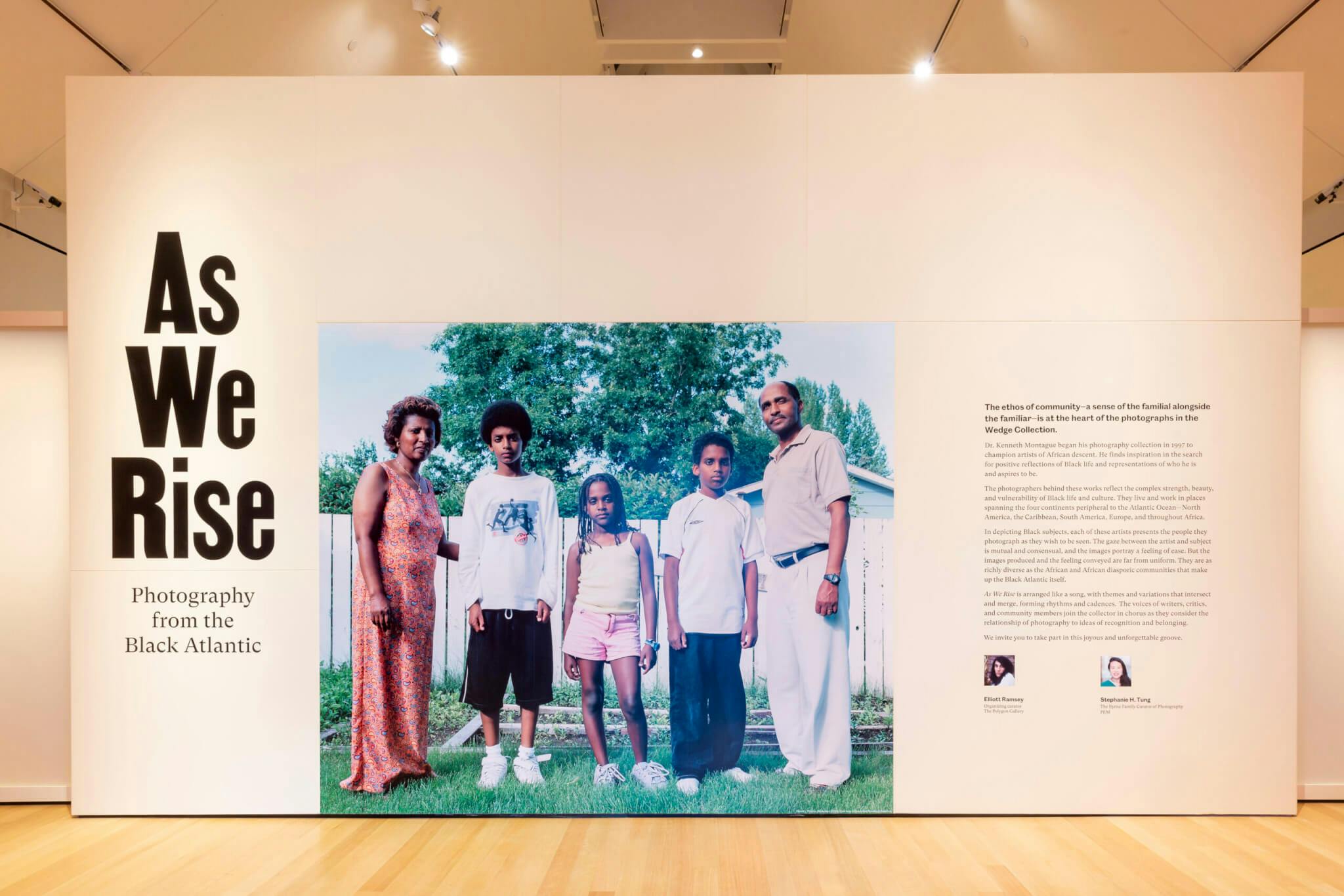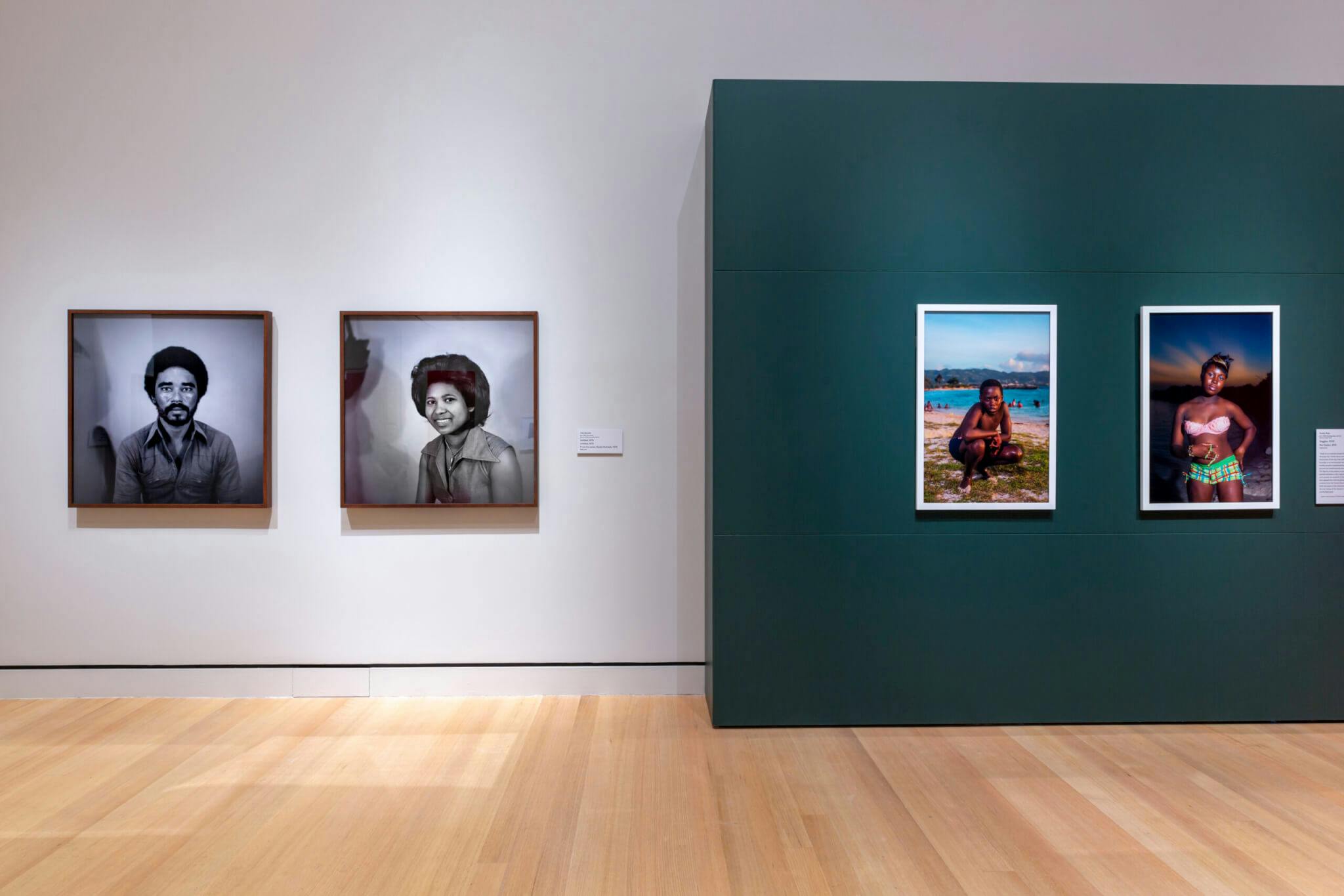A dentist’s office might be the last place you would expect to find work by internationally renowned artists. But at Word of Mouth Dentistry in Toronto, patients are greeted with three Jamel Shabazz photographs and a Kehinde Wiley painting before even sitting down to say “Ahhh.” Dr. Kenneth Montague, who is a dentist and the founder of the Wedge Collection, began collecting art in 1997, aspiring to showcase contemporary artists of the Black diaspora. The collection takes its name from its original location in a wedge-like space inside of Montague’s loft where he held salons in the 1990s. The collection is now one of the largest of its kind, comprising over four hundred works along with other reference materials. Organized by the nonprofit photography publisher Aperture, “As We Rise: Photography from the Black Atlantic” is an international touring exhibition featuring pieces curated from the Wedge Collection by Polygon Gallery’s Elliott Ramsey.
The exhibition is making a stop at the Peabody Essex Museum (PEM) in Salem through December 31, 2023. At the entrance to the gallery, a larger-than-life photograph depicting a family of five meets my gaze. Hadenbes (2005) by Dawit L. Petros presents the family members arranged by height in a form that resembles a parabola—a dip directs my eye to the center, where I focus on the face of a confident young Black girl. The photograph gives the impression that this girl is covered by two levels of protection: her older brothers directly beside her and then her parents on either side of them. Much like the modern family album, the kinds of photographs throughout the show vary from structured compositions to the art of everyday life; they present an amalgamation of private and spectacular moments. In the exhibition catalogue published by Aperture in 2021, writer and photographer Teju Cole writes on the feeling of ease that this produces: “These are family pictures. This is a family album.” What differs from a typical album is the scale and space. The exhibition demands a shift in the mode of our encounter. Rather than flipping through an album, we’re walking through space and feeling the photographs—and the people they depict—take up space with us.
At PEM, visitors move clockwise through three sections in the gallery: Community, Identity, and Power. The thematic trio distills much of the discourse about the Black Atlantic and defines the energy sources that have sustained us, affirming they are deeply intertwined. Any one of those elements requires the others to thrive. The title of the exhibition references a maxim often repeated by the collector’s father, Spurgeon Montague: “Lifting as we rise.” This means giving back to the community from which one comes while ascending toward personal fulfillment. The photographs show twentieth- and twenty-first-century sitters of all ages from throughout the Black Atlantic in joy, rest, contemplation, protest, dignity, and serenity. With over one hundred works on view, connections across time and space are abundant: from the Black interior spaces captured in Afonso Pimenta’s Cláudia and Children (1989) and Deana Lawson’s Coulson Family (2008) to the twosomes in Seydou Keïta’s portrait of twin babies Untitled (1953–57), Jamel Shabazz’s Best Friends (1981), and Rotimi Fani-Kayode’s Twins (1985).
In the Community section, James VanDerZee’s iconic photograph Couple in Racoon Coats (1932) caught my eye immediately. Posed before a lustrous two-door convertible Cadillac, a woman and man sport lavish fur coats on West 127th Street in Harlem. The woman is standing outside of the car next to the man in the passenger’s seat, and the driver’s seat awaits her. Their next move—their futurity—is in her hands. Shot during the Harlem Renaissance, the photograph stunningly captures Black elite—it is easy to see why it is among the photographer’s most recognizable images—yet the historical context of Couple in Racoon Coats is what situates it perfectly in “As We Rise.”
In the late nineteenth century, the New York City subway system expanded northward. To accommodate Manhattan’s growing middle class, developers began building in Harlem. When they faced difficulties filling these buildings with the anticipated white tenants, the new apartments became home to Black people from Lower Manhattan, the American South, and the Caribbean, initiating decades of racially driven battles to move Black people in and out of Harlem, battles through which the Black community’s cultural legacy has survived. Through VanDerZee’s lens, the position of this couple in this particular streetscape is a bold and passionate claim to the city and their belonging there.
Moving through the gallery, I hear the sounds of Amerie’s “1 Thing,” Sean Paul’s “Like Glue,” and a whole playlist of familiar tracks by musical artists from across the Black diaspora. In an interview on the museum’s blog, Montague emphasizes that music and photographs are key parts of his everyday life, coexisting in the spaces that he inhabits. To effectively present the Wedge Collection to the public, adding music to the gallery at PEM simply made sense to curator Stephanie Tung. And it works! Hearing these popular songs while looking at photographs that evoke a sense of kinship accentuates the feeling of being in good company.
Rounding the corner into the Identity section, viewers encounter portraits of Black women, poised and posed, by James Barnor, Xaviera Simmons, and Oumar Ly spanning the 1960s to present day. Senegal had recently gained independence from France when Ly began his photography practice by making identification cards for the new Senegalese government from his rural studio in Podor in 1963. In the black- and-white photograph Untitled, Bush Portrait, Woman, Podor, Senegal (1963–78), a subject stands tall in a sunny landscape and looks toward the photographer shooting from below. Elevated by heeled sandals, she is adorned with bangles on both wrists, chunky earrings, and a chevron-patterned boubou. As I study the photograph, suddenly the mystery within the flowing backdrop is revealed: eight gripping fingers float above the sitter’s head. A studio assistant is holding up a large, vertically striped backdrop. The woman posing is certainly constructing her identity, but this touching detail also evinces the reliance on community needed for that to occur. Here is just one of the instances where the exhibition’s themes gracefully intersect.
In Dear Sarah, a series from which two prints—Sarah (2016) and Stella (2016)—are included in the Power section, Ayana V. Jackson assumes the character of Sarah Forbes Bonetta, a Yoruba princess who was gifted by King Ghezo of Dahomey to England’s Queen Victoria. She reinterprets Sarah using large-scale photographs printed on polyester silk that sway suspended in the gallery. Their airy movement presents a contrast to the small dark tintype portraits by Bidemi Oloyede nearby. Jackson is known to sit (and run, squat, dive, and dance) for her own artworks. She believes there is a violence between photographer and subject in the act of making a photograph that she can absorb herself rather than inflicting on another. She wears a white Victorian dress, a white lace headband, and drop pearl earrings. In Sarah, her eyes are closed, as if she is entranced by her own imagination. The refusal of her gaze suggests whatever she is conjuring up in her mind is deeply enthralling and certainly far more gratifying than affirming a spectacle of herself. Moving around the large panels, I almost expect to see more of the figure. But the panels are not opaque; opposite sides of each invert the image, allowing Sarah’s presence to be felt no matter where I stand in relation to the fabric, but always on the artist’s terms.
“As We Rise” synthesizes the magnitude of the Black diaspora while signaling its boundlessness. Young girls assert their awareness and insist that we become self-conscious of our own looking when they look back in Aïda Muluneh’s Girl in the Car, Addis Ababa, Ethiopia (2001) and Dennis Morris’s Sister Cool (1974). Moments of care and support are captured in Kennedi Carter’s Untitled (Self-Portrait) (2020), where her father shaves her head during the COVID-19 pandemic, and Raphael Albert’s Miss Black & Beautiful Sybil McLean with fellow contestants, Hammersmith Palais London (1972), where competing beauties celebrate one another. Rashid Johnson’s The Reader (2008) presents a calm yet daring pursuit of knowledge. Two siblings dance and embrace worldly music and fashion in Malick Sidibé’s Nuit de Noël (Happy-Club) (1963) to close out the show. Photography is an actor in the magnificent project of uplift. I walk away with renewed gratitude for the medium and all the people who have lifted me.
“As We Rise: Photography from the Black Atlantic,” featuring works from the Wedge Collection, is on view at the Peabody Essex Museum in Salem, Massachusetts, through December 31, 2023, during its North American tour.
This review was originally published in print in Issue 11: Emerge in November 2023.



